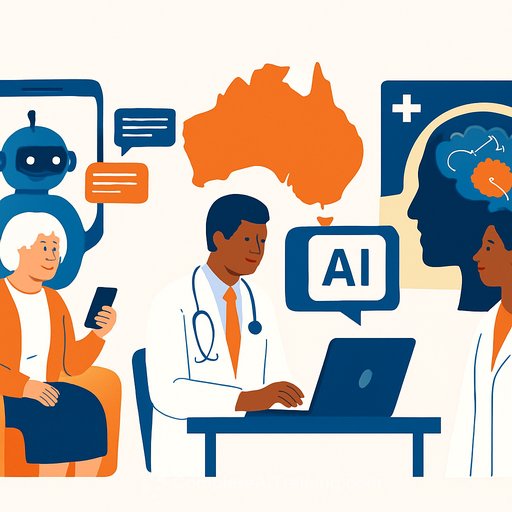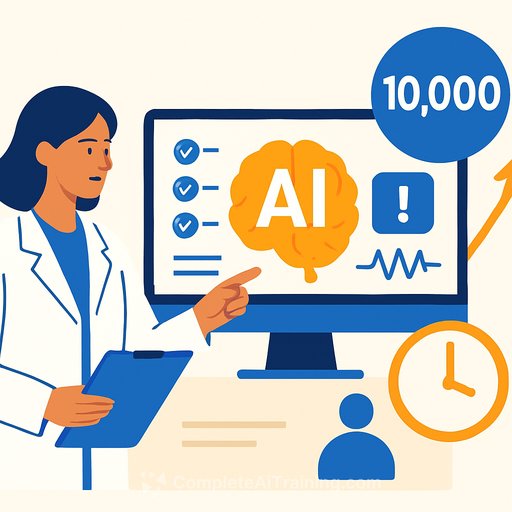AI moves from pilot to practice in Australia's health system
A 10am call from "Aida," a home care voice bot, became routine for Peta Rolls. Simple prompts like "How are you today?" gave her space to flag symptoms and share plans. "I was so overtaken by how responsive she was. It was impressive for a robot," she said.
That trial at St Vincent's At Home, built with Healthily, shows a clear pattern: use AI to extend care between visits, log issues, and escalate risk. It didn't replace weekly face-to-face time. It reduced busywork and surfaced concerns faster.
Where AI is already helping clinicians
Home care bots handle daily check-ins, capture mood and activity, and alert teams to red flags. Healthily set guardrails so serious symptoms trigger an immediate handover to care teams and, if needed, a prompt to call triple zero. No adverse incidents were reported during the trial's first phase.
GPs are adopting AI scribes that capture the consult and produce a structured note. Doctors report better eye contact, fewer distractions, and cleaner records. With stronger digital records, AI can also help avoid duplicated tests and scans.
Diagnostics: faster triage, clinician-led decisions
Older AI has long supported image reading and lab work. Newer deep learning systems add speed and sensitivity, while doctors retain responsibility for decisions. BreastScreen NSW introduced machine reading to support radiologists on select cases, with specialists still interpreting results.
In epilepsy, a team at the Murdoch Children's Research Institute and UCL trained an "AI detective" to find focal cortical dysplasias on MRI and PET. In a recent study, it detected lesions in up to 94% of cases for a subtype often missed more than half the time. Of 17 children in the test set, 12 had surgery and 11 are now seizure free. The model highlights suspicious regions; clinicians review and decide.
Public health signal detection
Deep neural networks are also scanning data streams to spot early outbreak signals. BlueDot, founded by infectious disease experts, was among the first to flag Covid-19 in its early days, showing how automated monitoring can give public health a time advantage.
Why this matters now
Workforce shortages and administrative fatigue are not going away. AI that handles routine monitoring, documentation, and triage creates more space for clinical work and patient relationships. The key is strict governance and clear escalation paths.
How to pilot AI safely in your service
- Start with low-risk, high-friction tasks: daily check-ins, scribing, intake summaries, recalls.
- Map escalation rules: chest pain, new neuro deficits, suicide risk, sepsis flags. Define who gets notified and how fast.
- Keep a human in the loop: staff validate outputs, patients can reach a person, and exceptions are clear.
- Integrate with the record: standard templates, coded data, audit trails, and easy clinician sign-off.
- Consent and transparency: tell patients when AI is used, what's recorded, and how alerts work.
- Privacy and security: data minimisation, Australian data residency where required, encryption, vendor DPAs.
- Bias checks: test across age, sex, language, and comorbidity groups; monitor for drift.
- Measure outcomes: admin minutes saved, time to follow-up, diagnostic yield, unplanned admissions, patient experience.
- Plan incident response: log issues, hold regular safety reviews, and update prompts/guardrails based on learnings.
- Procurement due diligence: request model cards, validation data, post-market surveillance plans, and integration support.
Clinical pearls from current deployments
- Voice bots work best with short, structured prompts plus a simple "something else?" open question.
- AI scribes improve value when the note structure matches your templates and billing requirements.
- Image tools are assistive: set policy that clinicians remain the final decision-makers.
- Escalation beats reassurance: if unsure, route to a person quickly.
- Short pilots, tight scopes: 8-12 weeks, clear KPIs, and a go/no-go threshold.
What to watch next
- Personalised care: models that adjust monitoring frequency, education, and goals based on risk and preferences.
- Multimodal tools: combined text, audio, image, and sensor data to speed diagnosis and follow-up planning.
- Interoperability: cleaner integrations with GP software, hospital EMRs, and shared care plans.
- Regulation and assurance: clearer routes for software as a medical device and post-market monitoring.
Further reading
Upskill your team
If you're planning a pilot or rollout, structured training helps clinicians and managers speak the same language and set the right guardrails. See AI courses by job role for curated options.
Your membership also unlocks:






